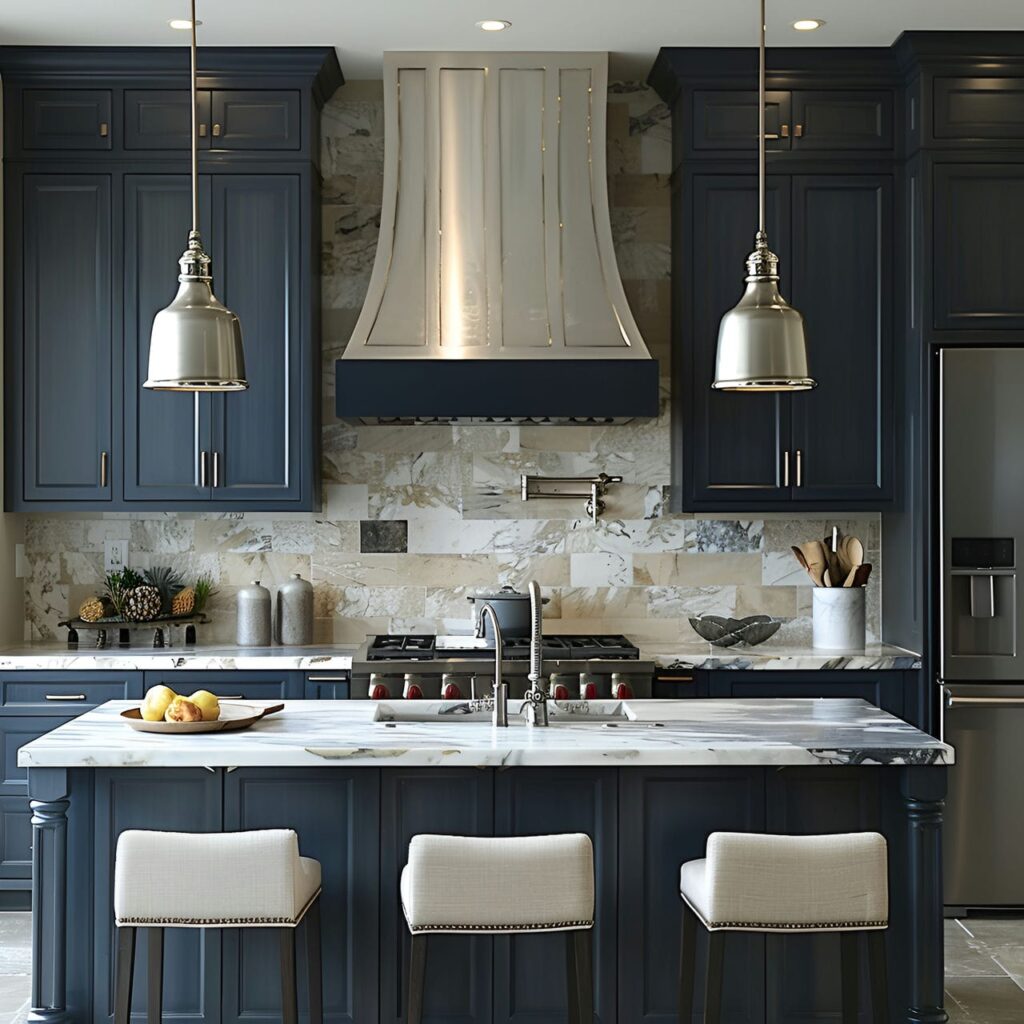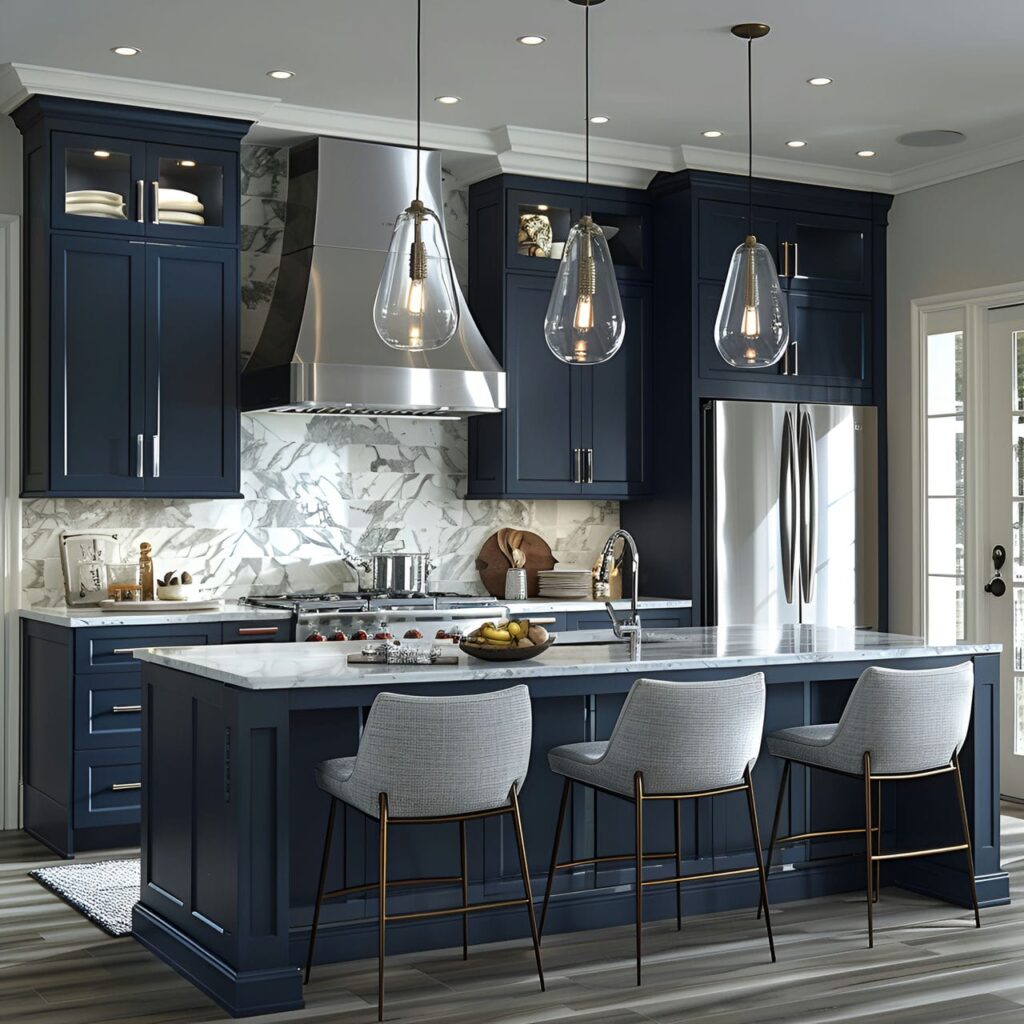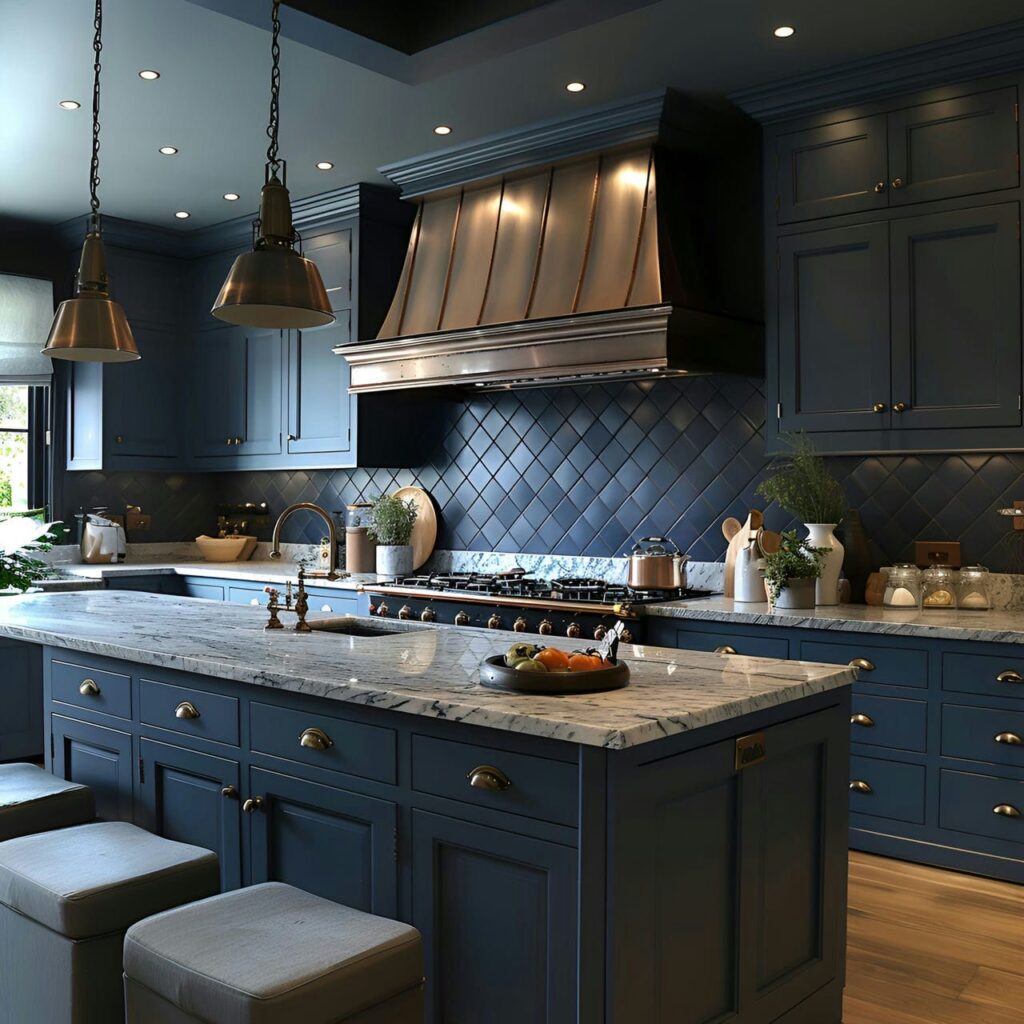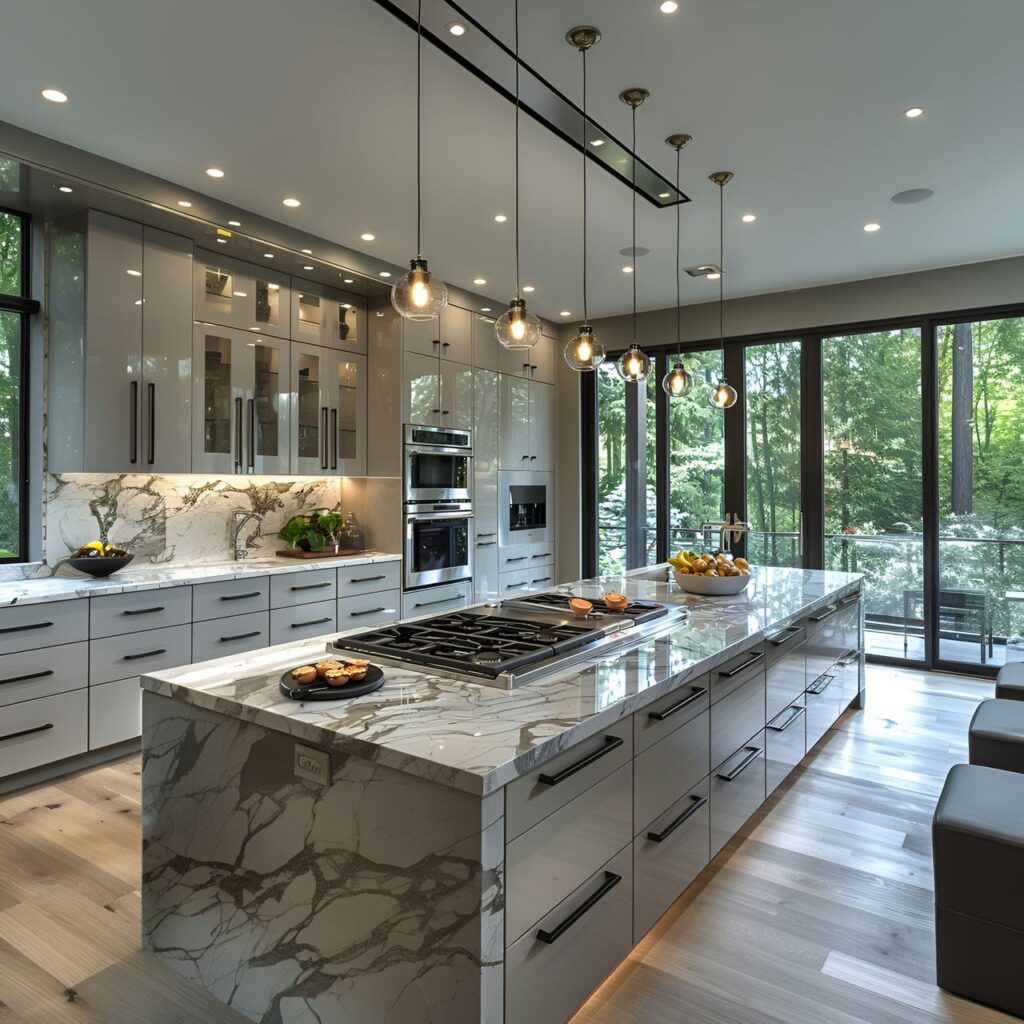Kitchen sizes range from 110 square feet (10 square meters) for standard homes to over 325 square feet (30 square meters) for luxury spaces. Layouts usually adopt square or rectangular shapes, creating efficient work triangles between appliances and maximizing usable space. Kitchens primarily serve for food storage, preparation, and cooking. They double as family living spaces, accommodating dining, socializing, and other household activities. Furnishing a kitchen involves cabinets for storage, islands for additional workspace and seating, dining tables and chairs, bar stools for casual seating, hutches or buffets for extra storage, kitchen carts for mobility and versatility, and step stools for accessibility. Ceiling heights in kitchens range from 8 feet (2.4 meters) to higher in luxury homes, with taller ceilings creating a sense of openness. Functional kitchens require efficient layouts, ample storage, task-specific lighting, reliable appliances, and durable materials. Energy efficiency in kitchens is achieved through high-efficiency appliances, strategic usage, upgraded lighting, improved insulation, air sealing, and integration of renewable energy sources. Hiring an architect can be essential for significant remodels, bringing expertise in design, material selection, budget management, structural changes, project management, value engineering, and Building Information Modeling (BIM). Depending on the project’s scope, redecorating a kitchen can take 3 to 8 weeks. Homeowners often face challenges like budget constraints, daily life disruptions, contractor issues, design and layout limitations, material and finish selection, unexpected problems, and living amidst construction.
What is the typical size of a kitchen?
A typical residential kitchen size ranges between 110 square feet (10 square meters) and 170 square feet (15 square meters). This allows fitting essential kitchen elements like 6 square feet (0.6 square meters) to 9 square feet (0.9 square meters) countertops, a 6 square feet (0.6 square meters) x 9 square feet (0.9 square meters) sink, 6 square feet (0.6 square meters) appliances, and room for three people. Standard 8-foot (2.4 meters) ceilings suit wall cabinets. The footprint enables one cook to prepare food comfortably and allows pairs to collaborate. The average home kitchen measures between 170 square feet (15 square meters) and 220 square feet (20 square meters). With 8-foot (2.4 meters) ceilings, average kitchens incorporate 12 square feet (1.2 square meters) long countertops, 9 square feet (0.9 square meters) wide stoves, tall pantry storage, and space for a dining table with 2-4 place settings nearby. This supports teams cooking together for gatherings in open floor plans.
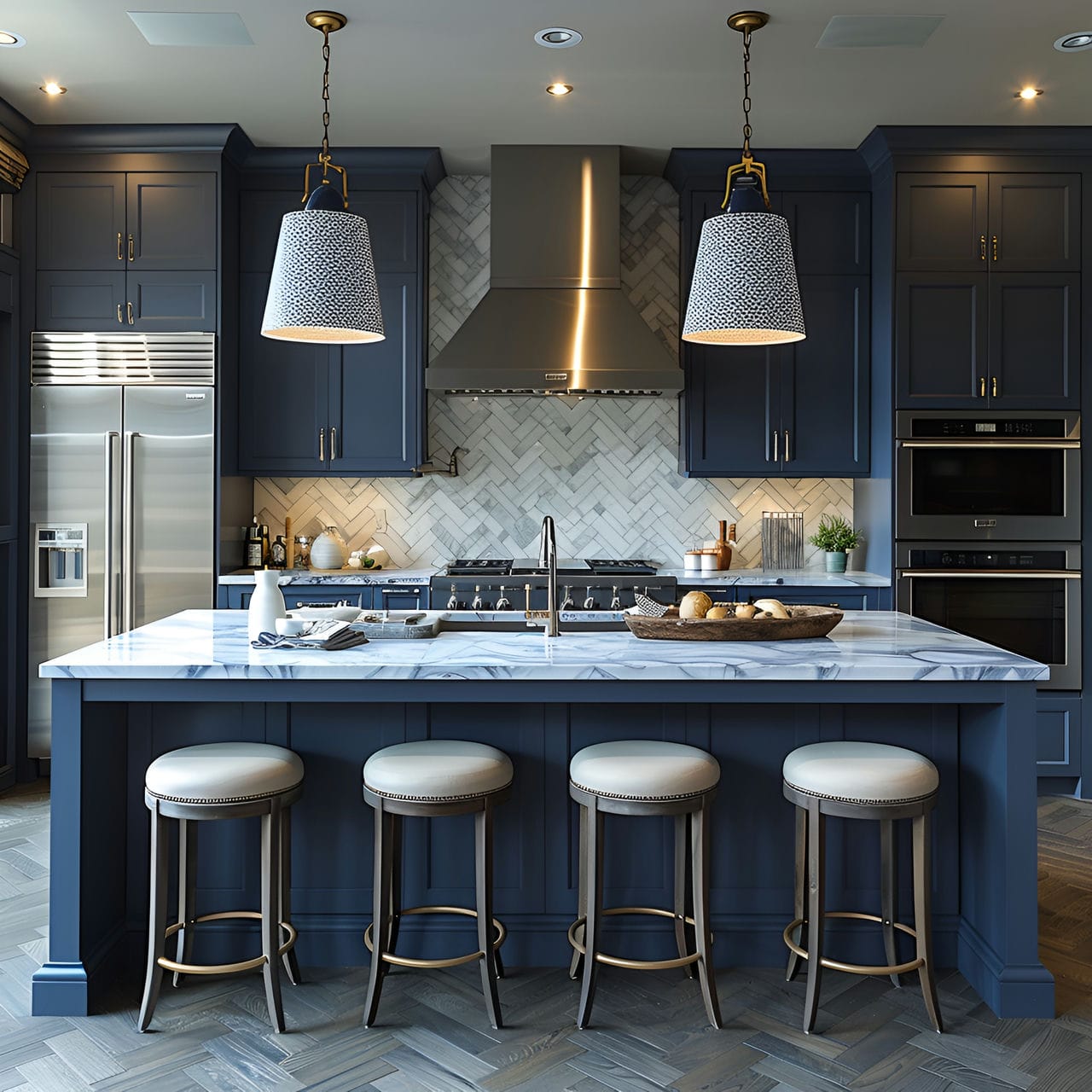
Spacious luxury home kitchens reach 325+ square feet (30+ square meters) to accommodate multiple cooks. Grand kitchens have long 40+ square feet (4+ square meters) countertops on multiple walls with double oven/stove tops and dual sinks for extensive meal preparation. Giant 30+ square feet (3+ square meters) expansive islands host prep, dining, and entertaining while walk-in pantries store supplies. Butler’s kitchens supplement additional ovens, sinks, and refrigeration hidden discreetly.
What is the use and purpose of a kitchen?
The use and purpose of a kitchen is for food storage, preparation, and cooking, and it serves many additional roles as an open family living space for dining. Firstly, a kitchen’s primary use and purpose is storing, preparing, and cooking food. It is the room in a home designated for meal preparation activities like washing, chopping, mixing, and cooking ingredients. Appliances like refrigerators, stoves, ovens, and microwaves facilitate storing and cooking food. Cabinets, countertops, and pantries provide storage space for dry goods, dishes, and utensils. Secondly, a kitchen serves as a space for eating meals and snacks. Most kitchens have a table, island, or breakfast nook for casual everyday meals. Kitchens may also be used for more formal family dinners or holiday meals. Open-concept kitchens connected to dining or great rooms allow a seamless transition between preparing and eating food. Lastly, kitchens provide space for cleaning up after meal preparation and eating. The sink, dishwasher, and waste bins allow for washing dishes, tidying up, and managing food waste. Kitchens may include cleaning supplies, towels, compost, and recycling bins.
What is the typical shape of a kitchen?
The typical shapes of a kitchen area are square or rectangular to enable an efficient work triangle between essential appliances and countertops. Standard rectangular layouts position cabinets, sinks, and stoves along one wall with dimensions spanning from 8 feet (2.5 meters) to 13 feet (4 meters) long and from 6.5 feet (2 meters) to 10 feet (3 meters) deep. These elongated rectangles concentrate appliances together linearly while maximizing prep space. Squared kitchens from 25 square feet (2.5 square meters) to 40 square feet (4 square meters) center stove tops and sinks centrally with uniform counters and storage along perimeter walls. Island bars frequently anchor the core hubs of both footprints. Contemporary open-concept kitchens maximize visibility and access by minimizing visual barriers in surrounding living areas.
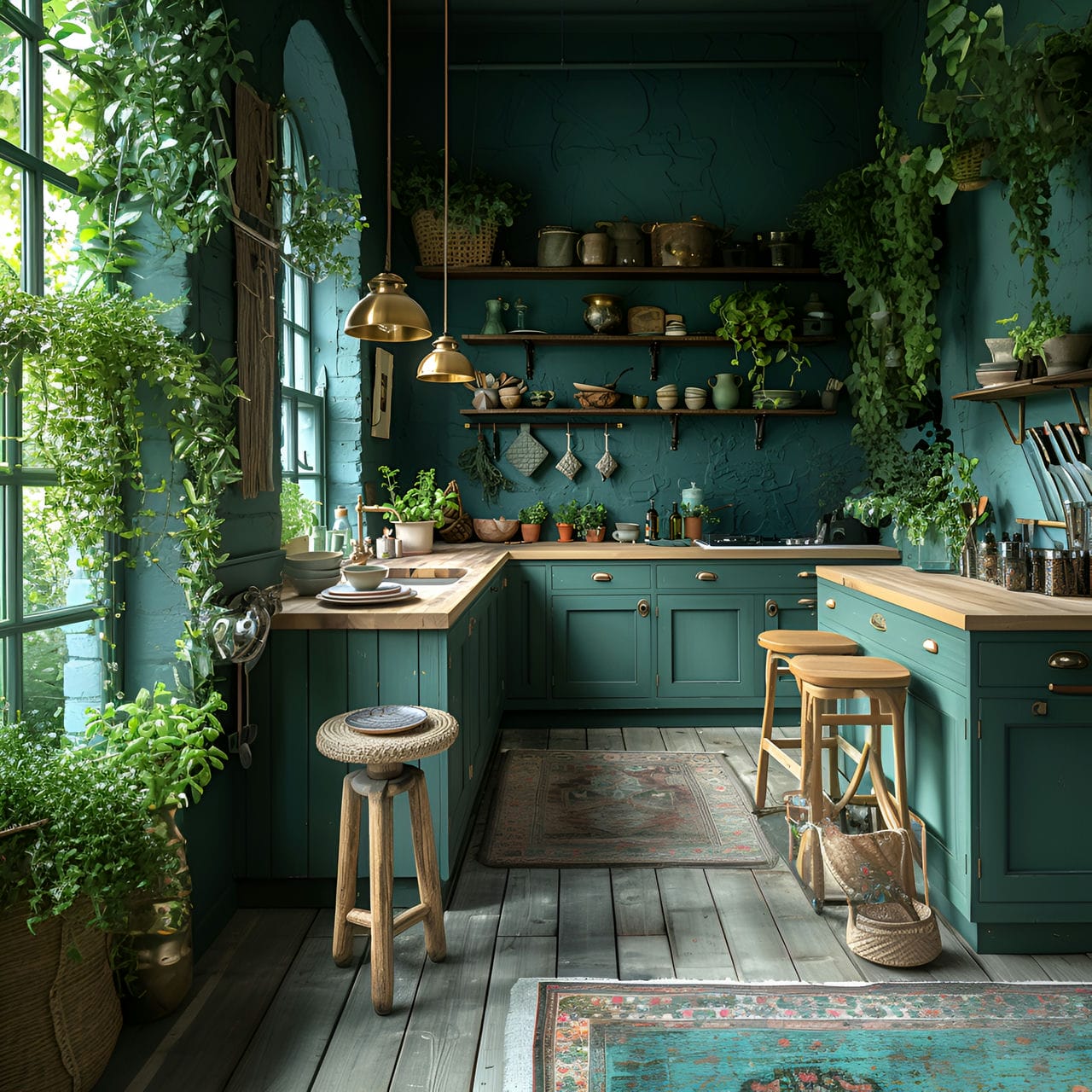
What furniture commonly equips a kitchen?
Listed below are the types of furniture commonly equip a kitchen:
- Kitchen Cabinets: Kitchen cabinets are essential for storage and organization in a kitchen. This furniture can provide space for storing dishes, utensils, pots, pans, and food items. Cabinets can be base units, wall units, or tall units, and they come in various styles and finishes to match the kitchen’s decor.
- Kitchen Island: A kitchen island serves multiple purposes, including additional workspace, storage, and seating. Some furniture is equipped with sinks or cooktops, while others are simpler, providing a large surface for food preparation or casual dining. Islands can be stationary or movable, depending on the kitchen’s layout and the homeowner’s needs.
- Dining Table and Chairs: The dining table and chairs in the kitchen are where meals are served. The table and chairs’ size and style depend on the kitchen’s size and the homeowner’s taste. This furniture can range from a small bistro set for two to a large table accommodating a big family or guests.
- Bar Stools: Bar stools can add a stylish touch to the kitchen and provide additional seating without taking up too much space. This furniture comes in various heights, styles, and materials; some models have adjustable heights for versatility.
- Kitchen Hutch or Buffet: A kitchen cabinet or buffet provides additional storage and display space. This furniture includes a combination of cabinets, drawers, and open shelves. A hutch or buffet can store dishes, glassware, or linens or display decorative items or cookbooks.
- Kitchen Cart: A kitchen cart is a movable piece of furniture that provides extra workspace and storage. It often includes shelves, drawers, or cabinets; some models have a built-in cutting board or wine rack.
- Step Stool: A step stool is a practical piece of furniture in a kitchen, especially if the cabinets are high. It provides a safe way to reach items stored on high shelves. Some step stools are foldable or slim enough to be stored easily when not in use.
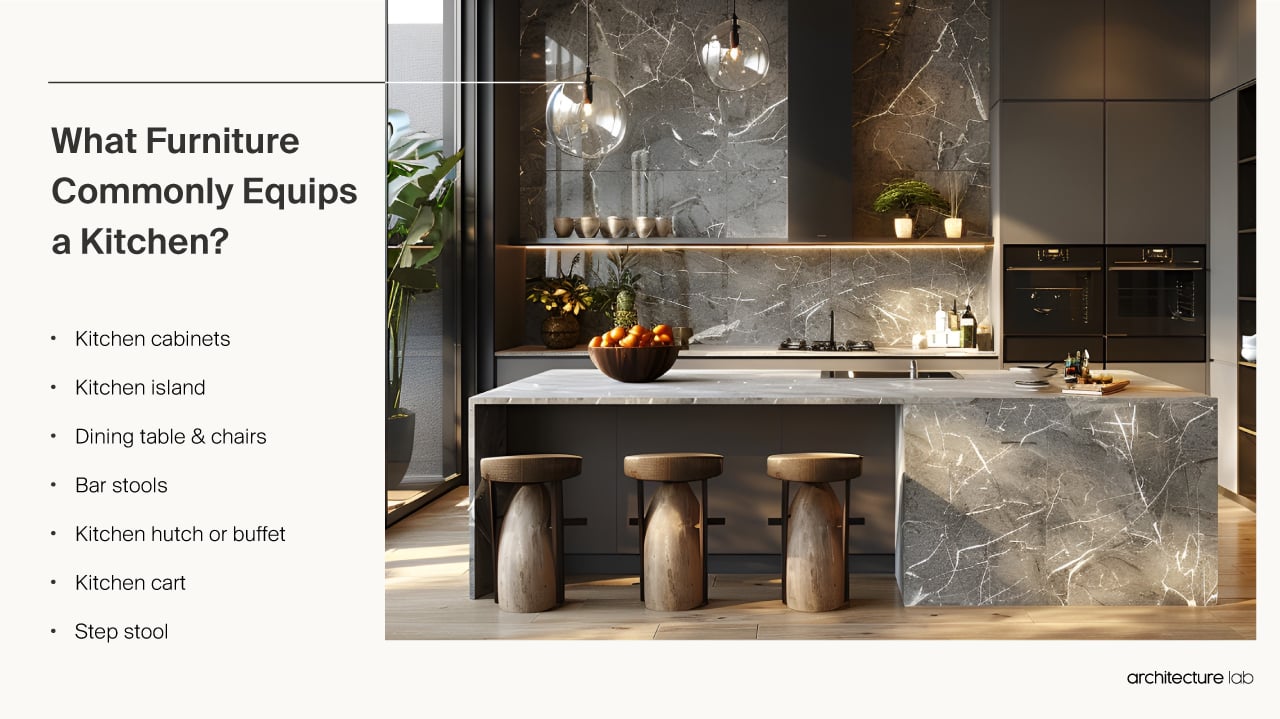
What is the normal ceiling height of a kitchen?
The normal ceiling height of a kitchen is between 26 square feet (2.4 square meters) and 29 square feet (2.7 square meters), following room standards. Standard heights allow typical clearance for wall cabinetry spanning up to 30 inches (0.75 meters) while maximizing the feeling of spaciousness. Contemporary kitchens may incorporate ceilings starting at 27 square feet (2.5 square meters) to 32 square feet (3 square meters), which provides a generous sense of volume for an open, airy interior design, even with furniture installed up to 1 meter (42 inches) high. Smaller footprint kitchens under 215 square feet (20 square meters) feel cramped, with ceiling heights exceeding 29 square feet (2.7 square meters). Luxury bespoke kitchens in upscale homes elevate architectural details with soaring ceiling heights up to 48 square feet (4.5 square meters).
What colors are kitchens usually painted?
Listed below are the colors usually used in kitchens:
- Soft White: White is the most popular kitchen paint color due to its neutrality, timelessness, and ability to brighten even the smallest kitchens. It offers a clean and airy look and can be used with any design style, from modern to traditional. White can easily be paired with other colors and textures, allowing design flexibility.
- Sage Green: Sage green is a soft, muted color that can create a soothing, natural feel in a kitchen. It pairs well with wood cabinets and accents and can add a touch of warmth to the space.
- Navy Blue: Navy blue is a rich, deep color that can add a touch of elegance to a kitchen. It is an accent color on a kitchen island or lower cabinets, especially when paired with white upper cabinets or walls. Navy blue can act almost as a neutral, complementing various other colors and finishes.
- Ash Gray: Ash gray is a versatile neutral color that can give a kitchen a modern, sophisticated look. It can serve as a backdrop for colorful accessories or be paired with white for a minimalist, monochromatic look. Gray is a popular choice for contemporary and industrial-style kitchens.
- Butter Yellow: Butter yellow is a warm, cheerful color that can make a kitchen feel cozy and inviting. It Is an excellent choice for a country or vintage-style kitchen, and it pairs well with white cabinets and natural wood accents. Butter yellow can add a sunny, welcoming vibe to the kitchen.
- Moss Green: Moss green is a deeper, earthy shade of green that can create a cozy, nostalgic mood in a kitchen. It pairs well with brown wood cabinets and can speak to the surrounding landscape, adding a touch of nature to the kitchen.
- Electric Blue: Electric blue is a color that can add energy to a kitchen. It works well in small kitchens, where it can make a bold statement without overwhelming the space. Electric blue can be paired with white for a crisp, contemporary look.
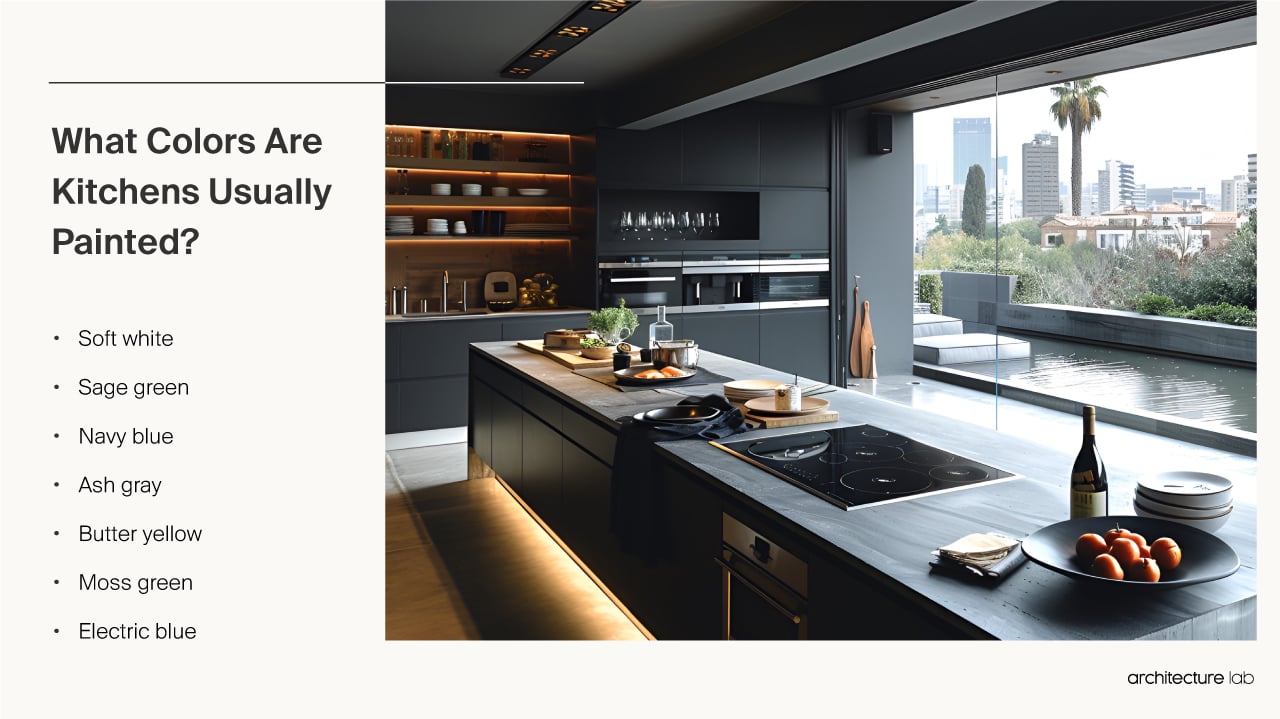
What makes the kitchen functional?
The kitchen is functional through efficient layout and workflow, storage, task-appropriate lighting, reliable appliances, and durable materials. Firstly, the kitchen layout and workflow, centered around the work triangle connecting the sink, stove, and refrigerator, enables smooth movement between key work zones for food preparation tasks. Ample counter space around these appliances further facilitates meal prep. Secondly, storage solutions make ingredients and cooking tools easily accessible while keeping clutter contained. Base cabinets and drawers store equipment, while wall cabinets provide space for dry goods and dishes. Pantries, islands with lower cabinets, and pull-out shelving further maximize storage density. Thirdly, the proper lighting brightens task areas on counters, illuminates work triangles, and sets the mood. Under-cabinet lighting brightens countertops. Lighting accommodates safe cooking, washing up, and social gatherings. Fourthly, kitchen appliances must reliably function in cooling, cooking, and cleaning. Quality full-size refrigerators and freezers preserve ingredients safely at proper temperatures. Stovetops quickly and evenly heat pots and pans via gas burners or electric coils. Lastly, material durability and cleanability enable a kitchen to withstand heavy daily use. Stainless steel offers appliance exteriors that resist corrosion. Quartz or granite counters hold up to hot pans, sharp knives, and staining. Tile backsplashes protect walls from moisture and splatters. Cabinet surfaces like melamine, thermofoil, or lacquer touch up quickly.
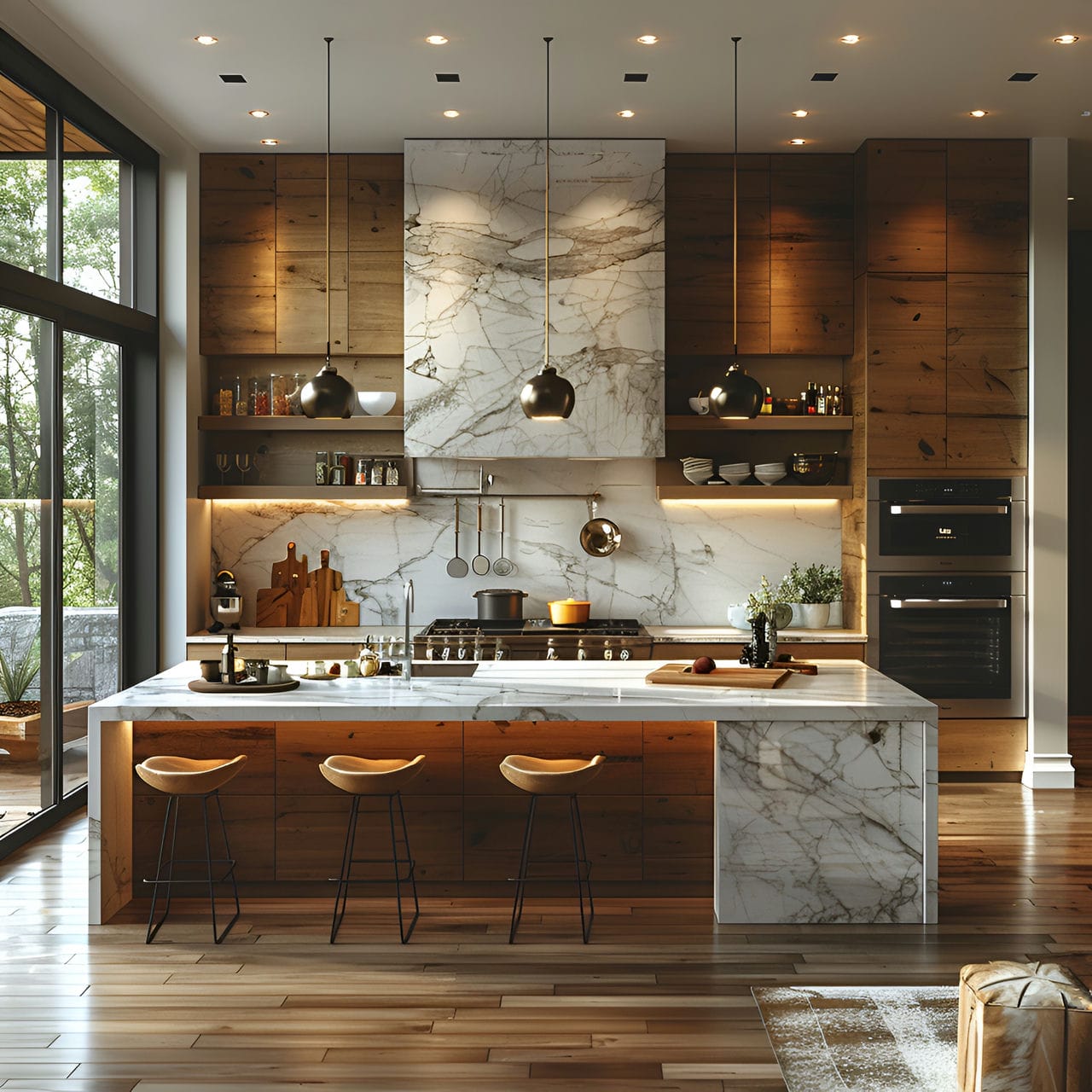
How is energy efficiency achieved in a kitchen?
Energy efficiency is achieved in a kitchen by purchasing high-efficiency EnergyStar appliances, upgrading lighting systems, improving insulation, sealing air leaks, and integrating solar or smart technology. Firstly, installing energy-efficient appliances is vital, as refrigerators, stoves, ovens, and dishwashers account for most kitchen energy use. Look for the EnergyStar label when purchasing appliances to ensure high efficiency. Induction stoves are the most efficient for cooking. Secondly, use appliances efficiently and minimize usage. Cover pots while cooking, fully load dishwashers before running them, and avoid opening the refrigerator more than necessary. Thirdly, replace lighting with energy-efficient LED bulbs. Under-cabinet lighting illuminates countertops as needed. Use dimmers, timers, and occupancy sensors so lighting is only on when required. Fourthly, insulate exterior walls and ceilings to high standards to prevent heat transfer. Seal air leaks around fixtures, pipes, wiring holes, and vents. Insulation keeps the kitchen at comfortable temperatures with less heating and cooling energy. Lastly, incorporate renewable energy like solar panels to supplement electricity needs and greenhouse efficiency. Solar water heating can provide most of the hot water a household needs. Innovative technology connects appliances and optimizes usage based on energy prices and demand.
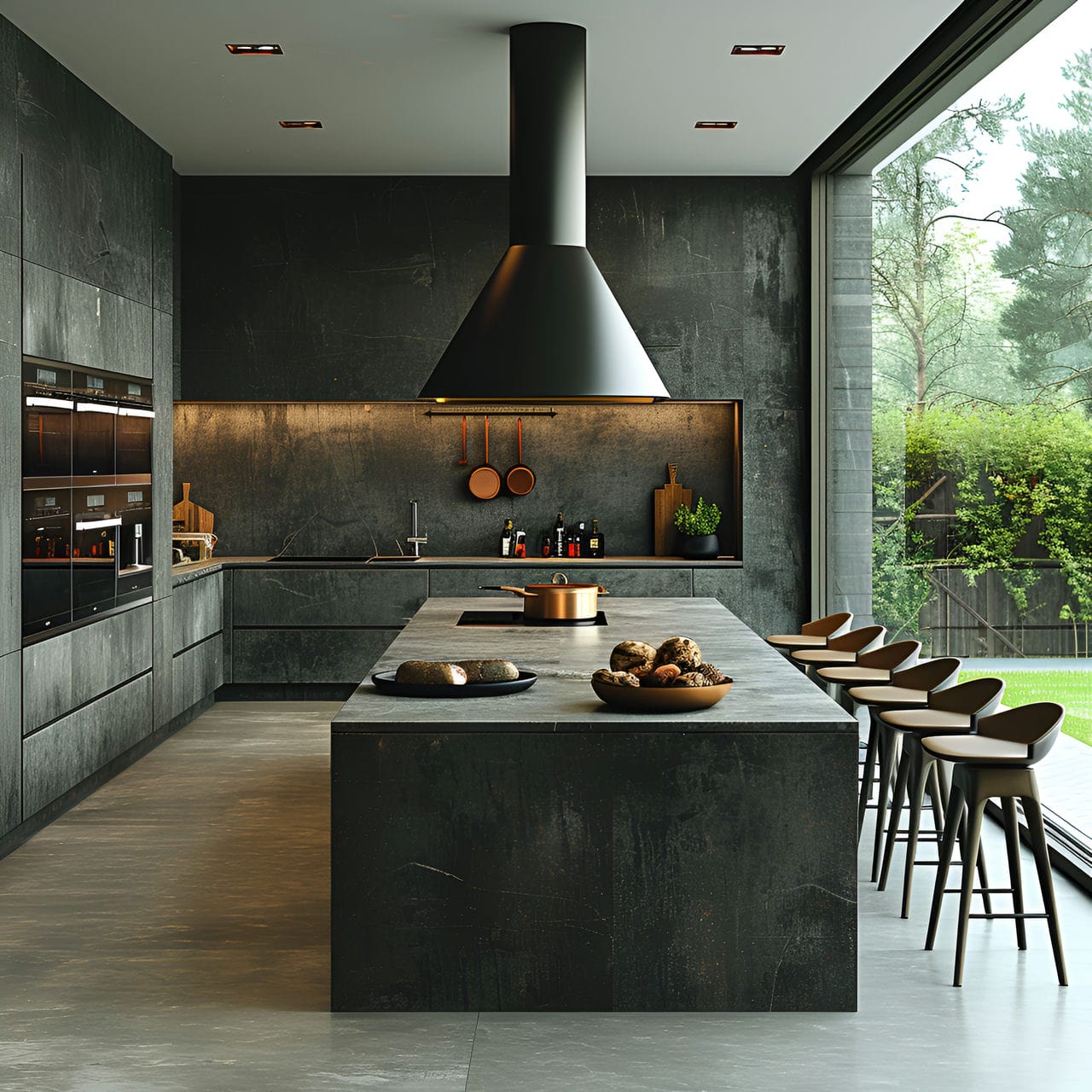
How much does it typically cost to renovate a kitchen?
The average cost to renovate an existing 115 square foot (10 square meter) to 215 square foot (20 square meter) residential kitchen falls between $15,000 (€13,500, £11,400) and $30,000 (€27,000, £22,500). Cosmetic updates like paint, new backsplash, and flooring run $15,000 (€13,500, £11,400) to $20,000 (€18,000, £15,000). Structural changes like moving walls or plumbing, new cabinetry, countertops, and appliances cost $30,000 (€27,000, £22,500). New stainless steel appliances range from $3,000 (€2,700, £2,300) to $15,000 (€13,500, £11,400) total for the refrigerator, range, microwave, and dishwasher combined. Custom or designer cabinetry costs $5,000 (€4,500, £3,800) to $20,000 (€18,000, £15,000) for semi-custom to fully bespoke. High-end countertops like quartz or granite fall $2,000 (€1,800, £1,500) to $5,000 (€4,500, £3,800) installed. For contemporary kitchens with luxury professional-grade appliances, exotic countertop materials, intricate cabinetry details, spatial expansions, or layout changes, total budgets exceed $50,000 (€45,00, £37,500). Typical renovations range from $15,000 (€13,500, £11,400) to $30,000 (€27,000, £22,500), while ultra-premium custom chef’s kitchens match budgets to ambitions.
What factors affect the kitchen renovation?
Listed below are the factors that affect the kitchen renovation:
- Budget: The budget is the most crucial factor in a kitchen renovation. It determines the extent of the renovation, the quality of materials used, and the appliances that can be upgraded. It is essential to allocate funds for unexpected costs, such as maintenance issues that might be discovered during the renovation process.
- Layout and Workflow: The kitchen layout significantly impacts its functionality. Changing the location of sinks, dishwashers, stoves, ovens, refrigerators, and lighting can dramatically improve the layout but will increase the overall cost of remodeling.
- Material Selection: The type of materials used in the renovation will significantly impact the kitchen’s cost and final look. It is essential to compare materials and understand how they will fit into lifestyle, considering factors like maintenance required and how the material will hold up to foot traffic, spills, and sunlight.
- Appliances: The choice of appliances is a significant factor in a kitchen remodel. Upgrading to professional-grade appliances can be essential for those who love to entertain, but it will also add to the cost of the renovation.
- Design and Aesthetics: The design and aesthetics of the kitchen should reflect the homeowner’s style and the house’s overall style. The renovation presents an opportunity to upgrade other parts of the house to reflect better the changes made in the kitchen.
- Structural Changes: Structural changes, such as removing walls, moving windows, and relocating utilities, can significantly impact the kitchen renovation cost. These changes can improve the kitchen’s layout and lighting but may require permits and increase the project’s cost.
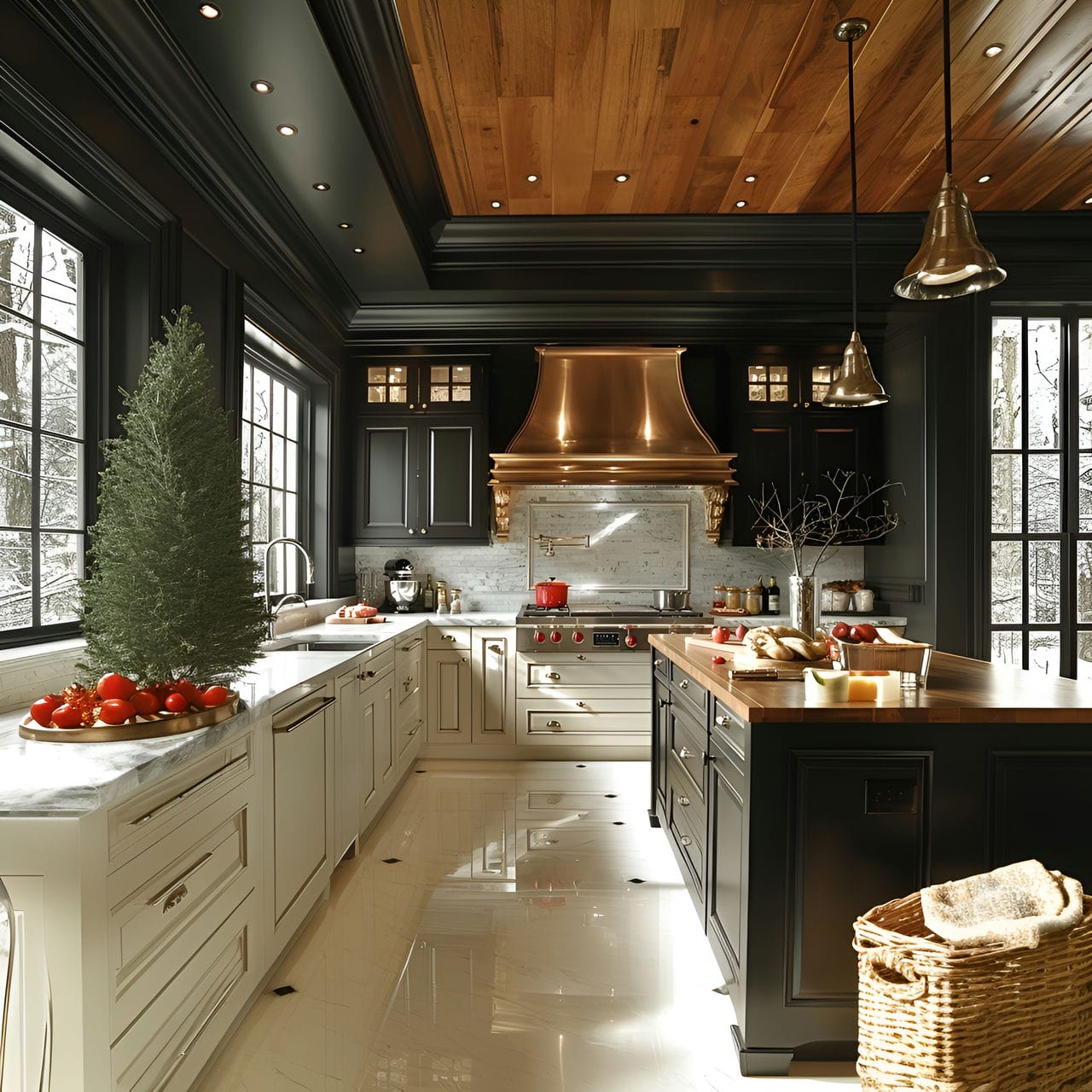
Is an architect required to renovate a kitchen?
No, hiring an architect for a kitchen renovation is not required by highly advised to hire one. An architect’s expertise is invaluable in reimagining and optimizing the kitchen layout, ensuring efficient space use, and integrating new elements. They can provide innovative design solutions that enhance functionality and aesthetics, addressing challenges such as limited space, awkward configurations, or specific user needs. An architect also ensures that the renovation adheres to building codes and safety standards, which is particularly important in a kitchen involving electrical and plumbing systems. An architect’s guidance is crucial for extensive renovations, including structural changes, like removing walls or altering windows and doors.
How can an architect help you upgrade a kitchen?
Listed below are ways an architect can help an owner upgrade a kitchen:
- Design Expertise: An architect brings professional design expertise to a kitchen upgrade. They can create a functional and aesthetically pleasing layout using the work triangle concept for easy and logical access to the sink, stovetop, and refrigerator.
- Material and Appliance Selection: Architects can guide homeowners in selecting the suitable materials and appliances for their kitchen. They can help compare materials and understand how they will fit into your lifestyle, considering factors like maintenance required and how the material will hold up to foot traffic, spills, and sunlight.
- Budget Management: Architects can help manage the budget for a kitchen upgrade. They can help establish what is most important to the homeowner, such as professional-grade appliances for those who love entertaining or moving windows for more light.
- Structural Changes: Architects can advise on potential structural changes, such as removing walls, moving windows, and relocating utilities. These changes can improve the kitchen’s layout and lighting but may require permits and increase the project’s cost.
- Project Management: An architect can manage the kitchen upgrade process, coordinating with contractors and other professionals. They can oversee the project from conception to completion, ensuring the renovation stays on schedule and within budget.
- Building Information Modeling (BIM): Architects can use BIM technology to plan the kitchen construction process effectively. BIM improves building management and planning, leading to a smoother and more efficient kitchen upgrade process. This technology is changing the game for collaboration in the Architecture, Engineering, and Construction (AEC) sector.
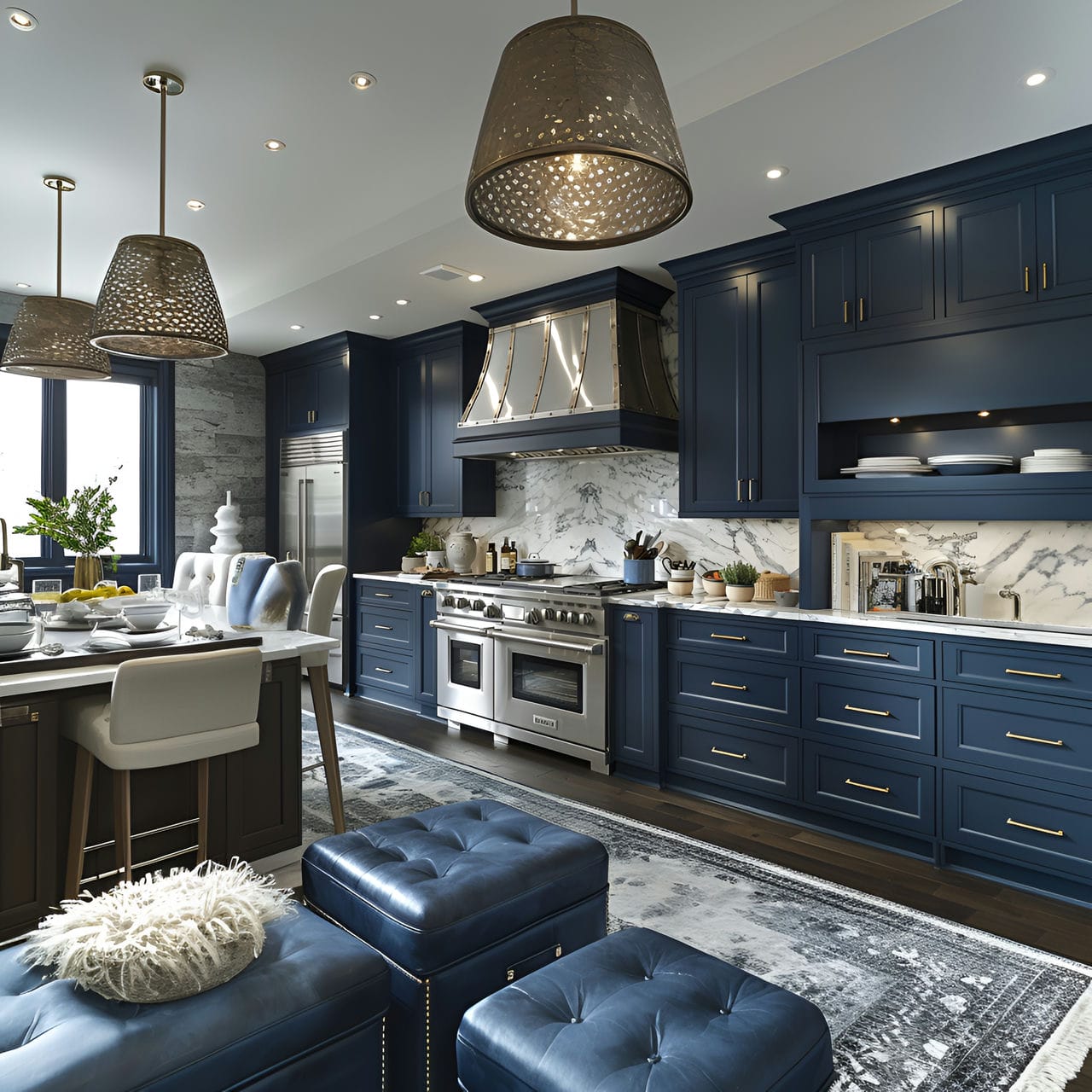
How much does it cost to hire an architect to renovate a kitchen?
The average cost to hire an architect to design a kitchen remodel ranges from $1,500 (€1,350, £1,150) to $5,000 (€4,500, £3,800) based on the scope and layout intricacy. Most residential architects charge $100 (€90, £75) to $175 (€155, £135) hourly. Refreshing an existing 115 square foot (10 square meters) kitchen with new cabinet facades, appliances, and lighting layout takes 10-15 hours, costing around $1,500 (€1,350, £1,150). Mid-range reconfigurations spanning 175 square feet (15 square meters), incorporating some changed footprints or windows, custom storage solutions, and luxury material finishes require closer to 20-30 hours of design time, averaging $3,000 (€2,700, £2,300). For high-end contemporary kitchens integrating top-tier professional appliances, exotic countertops, and bespoke custom cabinetry within open concept plans spanning 215+ square feet (20+ square meters), architects can charge $5,000 (€4,500, £3,800) or more. Their elaborate space-maximizing plans take 30-50 hours. Typical kitchen update concepts run $1,500 (€1,350, £1,150) to $3,000 (€2,700, £2,300), including some customized elements. Extensive chef-grade kitchen reimaginations allow innovative, integrated layouts to match the complexity from $3,000 (€2,700, £2,300) to $5,000+ (€4,500+, £3,800+).
Is it worth it to hire an architect to upgrade a kitchen?
Yes, hiring an architect to upgrade a kitchen is often worth the investment. An architect brings specialized expertise in design and space planning, which is crucial in a kitchen where functionality and aesthetics must be balanced. They can provide innovative solutions for maximizing space, improving workflow, and integrating modern appliances and fixtures. An architect’s skills are particularly valuable for complex renovations that involve altering the kitchen’s layout, removing walls, or making structural changes. They ensure that such modifications are visually appealing but also practical and compliant with building codes. Their involvement in managing the project, from design to execution, can alleviate the stress of a significant renovation. For homeowners looking to significantly enhance their kitchen’s usability and appeal, the expertise of an architect can be a crucial asset.
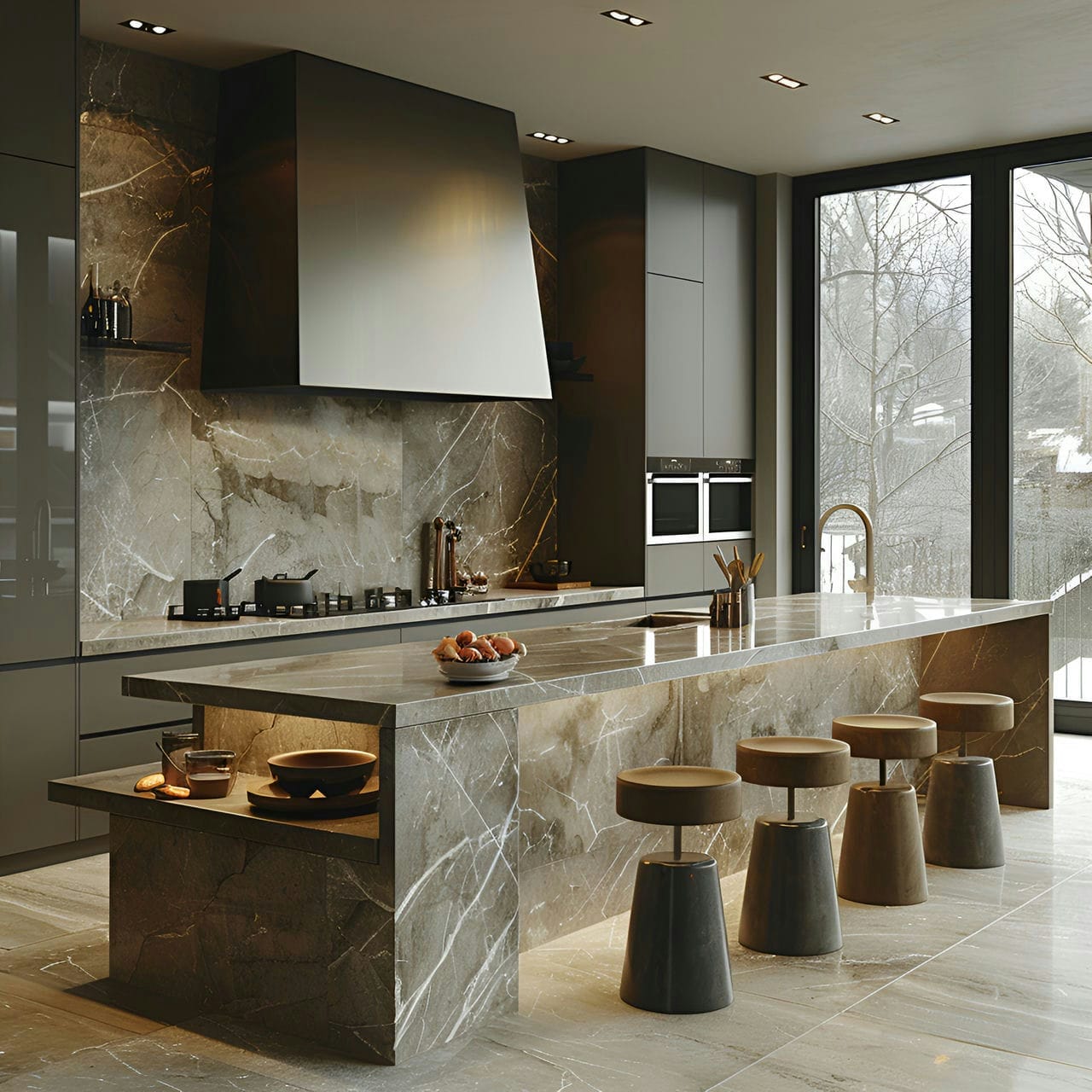
How long is needed to redecorate a kitchen?
Redecorating the kitchen typically requires a timeframe of 3 to 8 weeks. Firstly, simple cosmetic updates like painting, replacing cabinet doors, or installing new lighting can be completed relatively quickly, within a week or two. Secondly, more extensive projects like replacing countertops, installing new appliances, or retiling the floor extend the timeline. These tasks take 2 to 4 weeks, often involving more detailed work and coordination with various suppliers and professionals. Thirdly, if the redecoration involves significant structural changes, such as altering the layout, moving plumbing, or adding new electrical lines, the project duration can increase to 6 to 8 weeks or more. These renovations require careful planning, professional execution, and possibly the acquisition of permits. Fourthly, the availability of materials and contractors is a crucial factor. Delays in obtaining the necessary materials or scheduling professional services can extend the project’s duration. Lastly, unexpected challenges, such as discovering hidden issues with plumbing or wiring, can prolong the redecoration process.
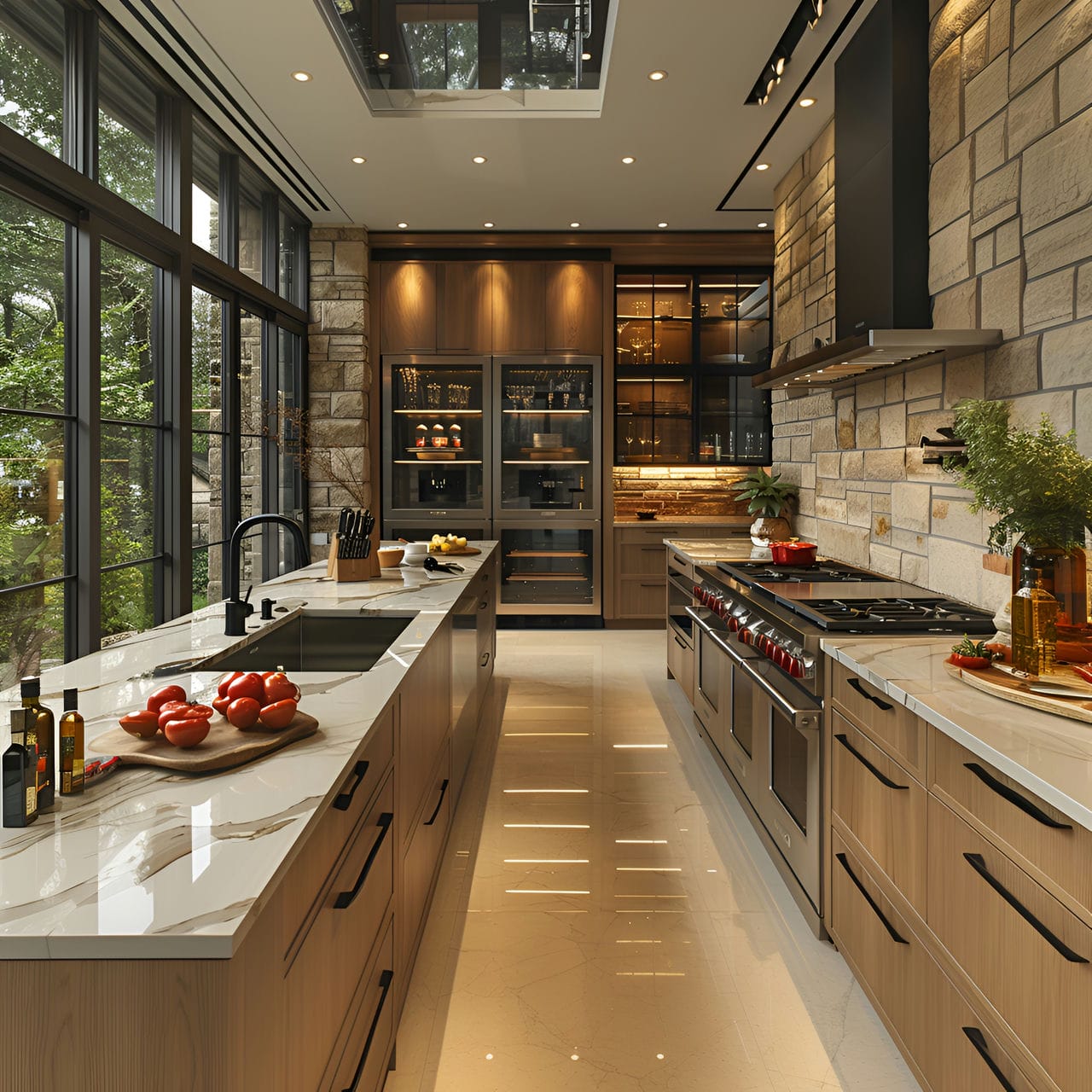
What are the struggles of the homeowner to redecorate a kitchen?
Listed below are the struggles of the homeowner to redecorate a kitchen:
- Lack of funds: Many homeowners find redecorating or remodeling their kitchen can be very expensive, with costs quickly adding up for new appliances, countertops, cabinets, flooring, and more.
- Disruption to daily life: A kitchen remodel often requires appliances to be disconnected and the kitchen rendered unusable for some time. This can be highly disruptive for households relying on their kitchen to prepare meals. Homeowners need to work on managing daily cooking and cleanup with full use of their kitchen during the renovation process.
- Contractor issues: Hiring contractors to do the kitchen renovation work can come with headaches for homeowners. Problems like delays, sloppy workmanship, personality clashes, and billing disputes between homeowners and contractors are common, leaving homeowners frustrated and over budget.
- Design and layout challenges: Creating an optimal kitchen design layout within the fixed dimensions of the existing space can pose a significant challenge. Homeowners need help to fit in all the features and appliances they want in a layout that makes practical sense for how they cook and use the kitchen.
- Living in a construction zone: Homeowners must cope with their home being a dusty, noisy construction zone, all of which are workers coming and renovating the kitchen. Dealing with the mess and chaos of construction while still carrying on with normal household functions can be a significant nuisance.
